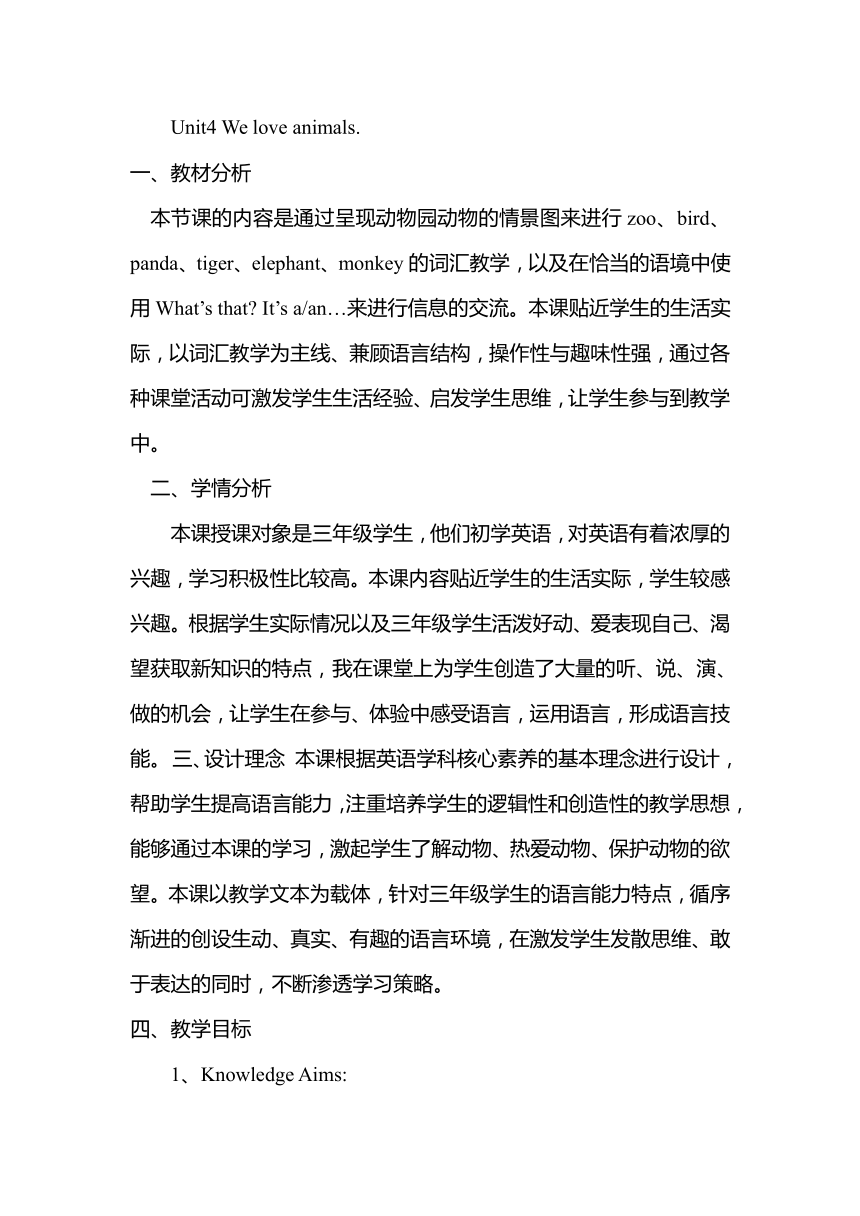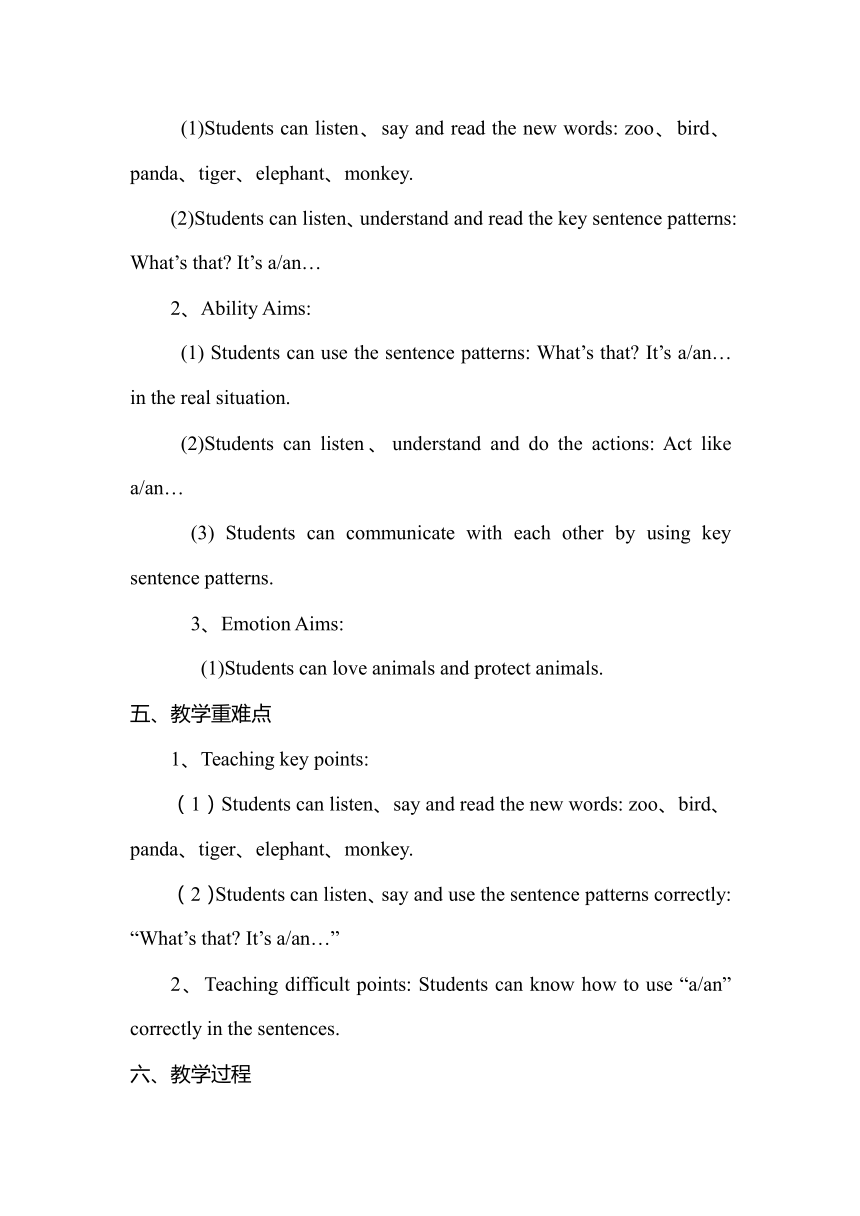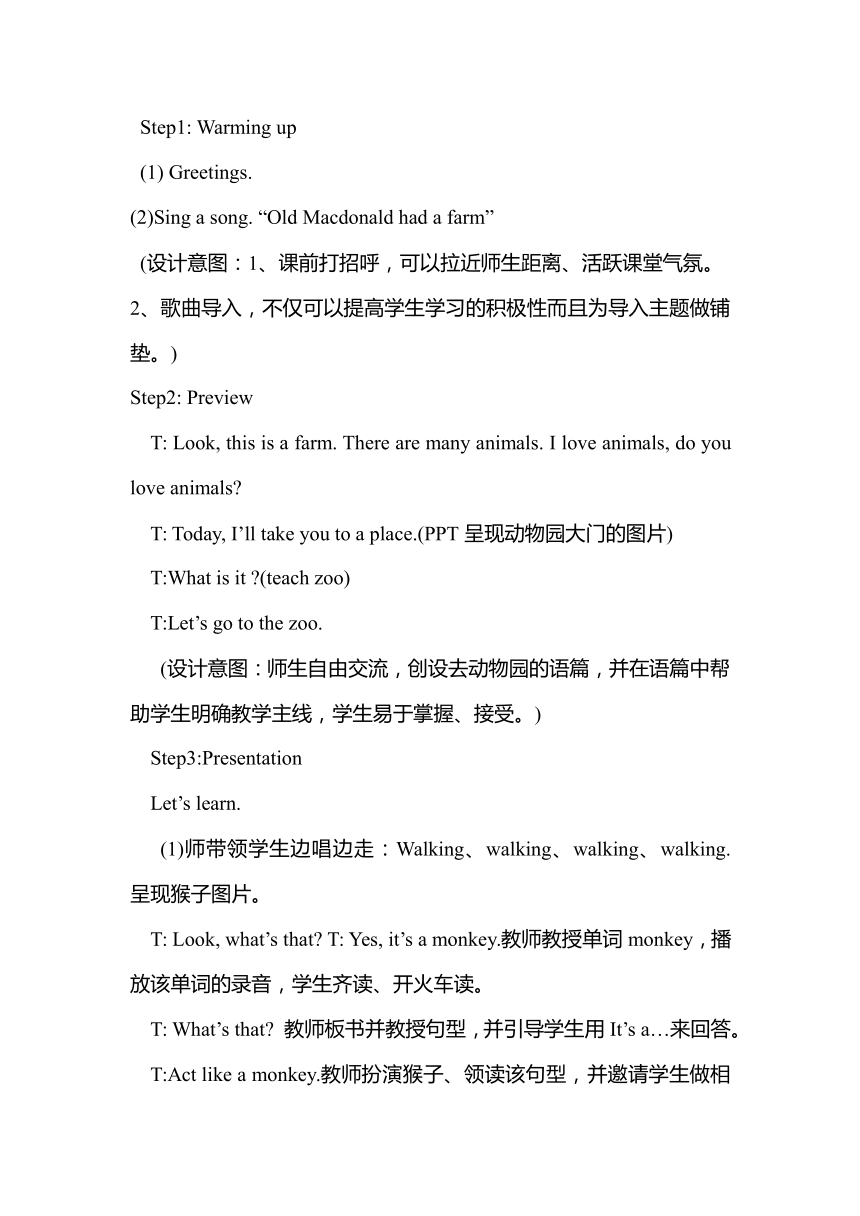Unit 4 We love animals Part B Let’s learn教学设计
文档属性
| 名称 | Unit 4 We love animals Part B Let’s learn教学设计 |  | |
| 格式 | docx | ||
| 文件大小 | 20.4KB | ||
| 资源类型 | 教案 | ||
| 版本资源 | 人教版(PEP) | ||
| 科目 | 英语 | ||
| 更新时间 | 2023-09-07 18:46:08 | ||
图片预览



文档简介
Unit4 We love animals.
一、教材分析
本节课的内容是通过呈现动物园动物的情景图来进行zoo、bird、panda、tiger、elephant、monkey的词汇教学,以及在恰当的语境中使用What’s that It’s a/an…来进行信息的交流。本课贴近学生的生活实际,以词汇教学为主线、兼顾语言结构,操作性与趣味性强,通过各种课堂活动可激发学生生活经验、启发学生思维,让学生参与到教学中。
二、学情分析
本课授课对象是三年级学生,他们初学英语,对英语有着浓厚的兴趣,学习积极性比较高。本课内容贴近学生的生活实际,学生较感兴趣。根据学生实际情况以及三年级学生活泼好动、爱表现自己、渴望获取新知识的特点,我在课堂上为学生创造了大量的听、说、演、做的机会,让学生在参与、体验中感受语言,运用语言,形成语言技能。 三、设计理念 本课根据英语学科核心素养的基本理念进行设计,帮助学生提高语言能力,注重培养学生的逻辑性和创造性的教学思想,能够通过本课的学习,激起学生了解动物、热爱动物、保护动物的欲望。本课以教学文本为载体,针对三年级学生的语言能力特点,循序渐进的创设生动、真实、有趣的语言环境,在激发学生发散思维、敢于表达的同时,不断渗透学习策略。
四、教学目标
1、Knowledge Aims:
(1)Students can listen、say and read the new words: zoo、bird、panda、tiger、elephant、monkey.
(2)Students can listen、understand and read the key sentence patterns: What’s that It’s a/an…
2、Ability Aims:
(1) Students can use the sentence patterns: What’s that It’s a/an… in the real situation.
(2)Students can listen、understand and do the actions: Act like a/an…
(3) Students can communicate with each other by using key sentence patterns.
3、Emotion Aims:
(1)Students can love animals and protect animals.
五、教学重难点
1、Teaching key points:
(1)Students can listen、say and read the new words: zoo、bird、panda、tiger、elephant、monkey.
(2)Students can listen、say and use the sentence patterns correctly: “What’s that It’s a/an…”
2、Teaching difficult points: Students can know how to use “a/an” correctly in the sentences.
六、教学过程
Step1: Warming up
(1) Greetings.
(2)Sing a song. “Old Macdonald had a farm”
(设计意图:1、课前打招呼,可以拉近师生距离、活跃课堂气氛。
2、歌曲导入,不仅可以提高学生学习的积极性而且为导入主题做铺垫。)
Step2: Preview
T: Look, this is a farm. There are many animals. I love animals, do you love animals
T: Today, I’ll take you to a place.(PPT呈现动物园大门的图片)
T:What is it (teach zoo)
T:Let’s go to the zoo.
(设计意图:师生自由交流,创设去动物园的语篇,并在语篇中帮助学生明确教学主线,学生易于掌握、接受。)
Step3:Presentation
Let’s learn.
(1)师带领学生边唱边走:Walking、walking、walking、walking.呈现猴子图片。
T: Look, what’s that T: Yes, it’s a monkey.教师教授单词monkey,播放该单词的录音,学生齐读、开火车读。
T: What’s that 教师板书并教授句型,并引导学生用It’s a…来回答。
T:Act like a monkey.教师扮演猴子、领读该句型,并邀请学生做相应的动作。
(设计意图:创设情境带领学生步行进入动物园,让学生在语篇中学习新知,激发学生的学习兴趣。)
(2)师带领学生边唱边走:Walking、walking、walking、walking,同时播放鸟儿叫的声音。
T: Listen! What’s that 引导学生说出小鸟,同时播放bird的单词录音,带读并让学生齐读、大小声读。
T: What’s that It’s a bird.
T:Act like a bird.扮演小鸟并带读。邀请学生上台扮演小鸟,并适时鼓励。
(3)师带领学生边唱边走:Walking、walking、walking、walking.课件呈现谜语,让学生猜出熊猫。出示熊猫图片和单词,播放panda单词录音,教授该单词。
T: What’s that 教授句型,领读、让学生看图用句型It’s a…来进行问答。
T: Act like a panda.师带领学生扮演熊猫并让学生上台表演。
(4)师带领学生边唱边走:Walking、walking、walking、walking.播放老虎吼叫的声音,让学生猜出老虎。播放tiger的单词录音,全班齐读并使用What’s that It’s a …来进行问答。
T: Act like a tiger.师带领学生扮演老虎并邀请学生上台进行表演。
(5)师带领学生边唱边走:Walking、walking、walking、walking.PPT呈现大象图片,播放elephant的单词录音,学生齐读、开火车读。同时讲解a/an的用法,并引导学生举例an egg/apple等。
T: Act like an elephant.师带领学生扮演大象并邀请学生上台进行表演。
(设计意图:1、在教授新词环节,采用听声音,猜谜语,看动物特征来导入新词,在单词带读方面, 采用开火车,大小声等形式, 改变了枯燥无味的教师带读,学生跟读的单一形式,让学生在轻松愉快的氛围中学习新知。2、将重点句型 “What’s that It’s a/an ….” “Act like a/an ….”放在单词教授环节,做到单词与句型有机结合,并在语境中教授,让学生整体感知语言。)
(6)Let’s listen and repeat.
Step 4: Let’s do.
(1)Let’s chant. (2) Let’s do. (3) Let’s play. Play a game. “Simon says” (设计意图:让学生在“唱”、“玩”、“演”中巩固新知,并能听懂教师发出的指令。)
Step 5: Production
(1) Let’s match.
(2) Pair work. Please choose one or two pictures to ask and answer in pairs. eg:
A: What’s that
B: It’s a/an…
A: Cool. I like it.
(3)Show time.
Step6: Summary
(1)Show some pictures of animals.
(2)Animals are cute, they make our life colorful. Animals are our friends, please love and protect animals.
(设计意图:通过观看动物的图片,培养学生热爱动物、保护动物、热爱生活的良好品质。)
Step 7:Homework
1、Listen to the tape, read the new words and the dialogue.
2、Listen to the recording of Let’s do and do actions for your parents. Blackboard design
Unit4 We love animals. Part B Let’s learn. What’s that It’s a/an…
一、教材分析
本节课的内容是通过呈现动物园动物的情景图来进行zoo、bird、panda、tiger、elephant、monkey的词汇教学,以及在恰当的语境中使用What’s that It’s a/an…来进行信息的交流。本课贴近学生的生活实际,以词汇教学为主线、兼顾语言结构,操作性与趣味性强,通过各种课堂活动可激发学生生活经验、启发学生思维,让学生参与到教学中。
二、学情分析
本课授课对象是三年级学生,他们初学英语,对英语有着浓厚的兴趣,学习积极性比较高。本课内容贴近学生的生活实际,学生较感兴趣。根据学生实际情况以及三年级学生活泼好动、爱表现自己、渴望获取新知识的特点,我在课堂上为学生创造了大量的听、说、演、做的机会,让学生在参与、体验中感受语言,运用语言,形成语言技能。 三、设计理念 本课根据英语学科核心素养的基本理念进行设计,帮助学生提高语言能力,注重培养学生的逻辑性和创造性的教学思想,能够通过本课的学习,激起学生了解动物、热爱动物、保护动物的欲望。本课以教学文本为载体,针对三年级学生的语言能力特点,循序渐进的创设生动、真实、有趣的语言环境,在激发学生发散思维、敢于表达的同时,不断渗透学习策略。
四、教学目标
1、Knowledge Aims:
(1)Students can listen、say and read the new words: zoo、bird、panda、tiger、elephant、monkey.
(2)Students can listen、understand and read the key sentence patterns: What’s that It’s a/an…
2、Ability Aims:
(1) Students can use the sentence patterns: What’s that It’s a/an… in the real situation.
(2)Students can listen、understand and do the actions: Act like a/an…
(3) Students can communicate with each other by using key sentence patterns.
3、Emotion Aims:
(1)Students can love animals and protect animals.
五、教学重难点
1、Teaching key points:
(1)Students can listen、say and read the new words: zoo、bird、panda、tiger、elephant、monkey.
(2)Students can listen、say and use the sentence patterns correctly: “What’s that It’s a/an…”
2、Teaching difficult points: Students can know how to use “a/an” correctly in the sentences.
六、教学过程
Step1: Warming up
(1) Greetings.
(2)Sing a song. “Old Macdonald had a farm”
(设计意图:1、课前打招呼,可以拉近师生距离、活跃课堂气氛。
2、歌曲导入,不仅可以提高学生学习的积极性而且为导入主题做铺垫。)
Step2: Preview
T: Look, this is a farm. There are many animals. I love animals, do you love animals
T: Today, I’ll take you to a place.(PPT呈现动物园大门的图片)
T:What is it (teach zoo)
T:Let’s go to the zoo.
(设计意图:师生自由交流,创设去动物园的语篇,并在语篇中帮助学生明确教学主线,学生易于掌握、接受。)
Step3:Presentation
Let’s learn.
(1)师带领学生边唱边走:Walking、walking、walking、walking.呈现猴子图片。
T: Look, what’s that T: Yes, it’s a monkey.教师教授单词monkey,播放该单词的录音,学生齐读、开火车读。
T: What’s that 教师板书并教授句型,并引导学生用It’s a…来回答。
T:Act like a monkey.教师扮演猴子、领读该句型,并邀请学生做相应的动作。
(设计意图:创设情境带领学生步行进入动物园,让学生在语篇中学习新知,激发学生的学习兴趣。)
(2)师带领学生边唱边走:Walking、walking、walking、walking,同时播放鸟儿叫的声音。
T: Listen! What’s that 引导学生说出小鸟,同时播放bird的单词录音,带读并让学生齐读、大小声读。
T: What’s that It’s a bird.
T:Act like a bird.扮演小鸟并带读。邀请学生上台扮演小鸟,并适时鼓励。
(3)师带领学生边唱边走:Walking、walking、walking、walking.课件呈现谜语,让学生猜出熊猫。出示熊猫图片和单词,播放panda单词录音,教授该单词。
T: What’s that 教授句型,领读、让学生看图用句型It’s a…来进行问答。
T: Act like a panda.师带领学生扮演熊猫并让学生上台表演。
(4)师带领学生边唱边走:Walking、walking、walking、walking.播放老虎吼叫的声音,让学生猜出老虎。播放tiger的单词录音,全班齐读并使用What’s that It’s a …来进行问答。
T: Act like a tiger.师带领学生扮演老虎并邀请学生上台进行表演。
(5)师带领学生边唱边走:Walking、walking、walking、walking.PPT呈现大象图片,播放elephant的单词录音,学生齐读、开火车读。同时讲解a/an的用法,并引导学生举例an egg/apple等。
T: Act like an elephant.师带领学生扮演大象并邀请学生上台进行表演。
(设计意图:1、在教授新词环节,采用听声音,猜谜语,看动物特征来导入新词,在单词带读方面, 采用开火车,大小声等形式, 改变了枯燥无味的教师带读,学生跟读的单一形式,让学生在轻松愉快的氛围中学习新知。2、将重点句型 “What’s that It’s a/an ….” “Act like a/an ….”放在单词教授环节,做到单词与句型有机结合,并在语境中教授,让学生整体感知语言。)
(6)Let’s listen and repeat.
Step 4: Let’s do.
(1)Let’s chant. (2) Let’s do. (3) Let’s play. Play a game. “Simon says” (设计意图:让学生在“唱”、“玩”、“演”中巩固新知,并能听懂教师发出的指令。)
Step 5: Production
(1) Let’s match.
(2) Pair work. Please choose one or two pictures to ask and answer in pairs. eg:
A: What’s that
B: It’s a/an…
A: Cool. I like it.
(3)Show time.
Step6: Summary
(1)Show some pictures of animals.
(2)Animals are cute, they make our life colorful. Animals are our friends, please love and protect animals.
(设计意图:通过观看动物的图片,培养学生热爱动物、保护动物、热爱生活的良好品质。)
Step 7:Homework
1、Listen to the tape, read the new words and the dialogue.
2、Listen to the recording of Let’s do and do actions for your parents. Blackboard design
Unit4 We love animals. Part B Let’s learn. What’s that It’s a/an…
